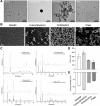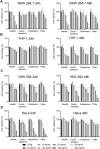Engineered Shape-Tunable Copper-Coordinated Nanoparticles for Macrophage Reprogramming
- PMID: 39914892
- PMCID: PMC11849021
- DOI: 10.1021/acs.nanolett.4c05999
Engineered Shape-Tunable Copper-Coordinated Nanoparticles for Macrophage Reprogramming
Abstract
The immune system safeguards as primary defense by recognizing nanomaterials and maintaining homeostasis, gaining a deeper understanding of these interactions may change the treating paradigm of immunotherapy. Here, we adopted copper as the principal component of nanoparticles (NPs), given its features of coordination with different benezenecarboxylate ligands to form metal-organic frameworks and complexes with distinct morphologies. As a result, four types of shape-tunable copper-coordinated NPs (CuCNPs) are developed: cuboctahedron, needle, octahedron, and plate NPs. Biocompatibility of CuCNPs varies across different cell lines (RAW264.7, THP-1, HEK 293 and HeLa) in a shape-dependent manner, with needle-shaped CuCNPs showing pronounced cytotoxicity (IC50:104.3 μg mL-1 at 24 h). Among different shapes, a notable increase of 8.47% in the CD206+ subpopulations is observed in needle-shaped CuCNPs, followed by 77% enhancement at 48 h. Overall, this study underscores the shape-dependent immune-regulatory effects of CuCNPs and sheds light on the rational design of nanoscale metal complexes for potential immunotherapy.
Keywords: Copper coordination nanocomplexes; Immune response; Macrophage reprogramming; Nanoparticles; Shape-tunable.
Conflict of interest statement
The authors declare no competing financial interest.
Figures






Similar articles
-
Green-synthesized silver-copper nanocomposites from Sargassum latifolium: antibacterial, anticancer, and in silico pharmacokinetic evaluation.Med Oncol. 2025 Jul 16;42(8):339. doi: 10.1007/s12032-025-02899-8. Med Oncol. 2025. PMID: 40670822
-
DS-Modified Paeoniflorin pH-Responsive Lipid-Polymer Hybrid Nanoparticles for Targeted Macrophage Polarization in a Rat Model of Rheumatoid Arthritis.Int J Nanomedicine. 2025 Jul 12;20:8967-8992. doi: 10.2147/IJN.S516434. eCollection 2025. Int J Nanomedicine. 2025. PMID: 40671689 Free PMC article.
-
Biological activities of optimized biosynthesized selenium nanoparticles using Proteus mirabilis PQ350419 alone or combined with chitosan and ampicillin against common multidrug-resistant bacteria.Microb Cell Fact. 2025 Jul 5;24(1):159. doi: 10.1186/s12934-025-02783-0. Microb Cell Fact. 2025. PMID: 40618114 Free PMC article.
-
Cuproptosis: a novel therapeutic mechanism in lung cancer.Cancer Cell Int. 2025 Jun 24;25(1):231. doi: 10.1186/s12935-025-03864-1. Cancer Cell Int. 2025. PMID: 40555995 Free PMC article. Review.
-
Portion, package or tableware size for changing selection and consumption of food, alcohol and tobacco.Cochrane Database Syst Rev. 2015 Sep 14;2015(9):CD011045. doi: 10.1002/14651858.CD011045.pub2. Cochrane Database Syst Rev. 2015. PMID: 26368271 Free PMC article.
References
-
- Lee D.; Huntoon K.; Lux J.; Kim B. Y. S.; Jiang W. Engineering Nanomaterial Physical Characteristics for Cancer Immunotherapy. Nat. Rev. Bioeng 2023, 1 (7), 499–517. 10.1038/s44222-023-00047-3. - DOI
-
- Jiang Y.; Krishnan N.; Zhou J.; Chekuri S.; Wei X.; Kroll A. V.; Yu C. L.; Duan Y.; Gao W.; Fang R. H.; et al. Engineered Cell-Membrane-Coated Nanoparticles Directly Present Tumor Antigens to Promote Anticancer Immunity. Adv. Mater. 2020, 32 (30), 2001808.10.1002/adma.202001808. - DOI - PMC - PubMed
-
- Lv Q.; Yu R.; Shi R.; Tan Z. a. Recent Progress in Organic–Metal Complexes for Organic Photovoltaic Applications. Mater. Chem. Front 2023, 7 (21), 5063–5103. 10.1039/D3QM00603D. - DOI
Publication types
MeSH terms
Substances
LinkOut - more resources
Full Text Sources
Research Materials
Miscellaneous

